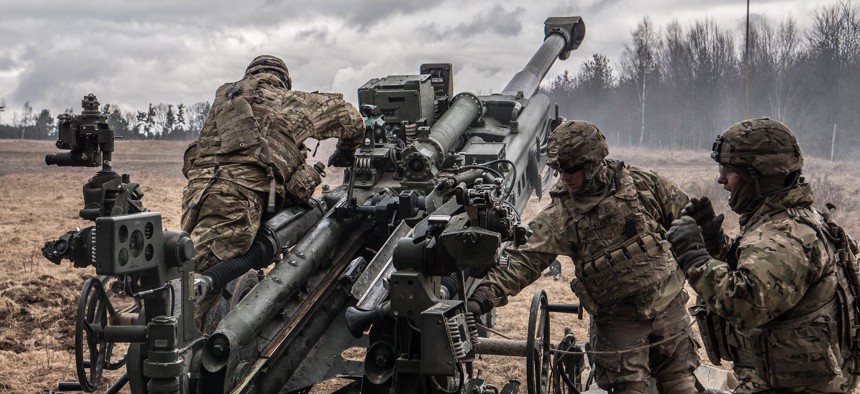
U.S. soldiers prepare to fire Howitzer during exercise Dynamic Front at Grafenwoehr military base, Germany on March 7, 2018. NATO photo
US to Begin Removing 12,000 Troops From Germany ‘Within Weeks’
The Pentagon says this is about Russia. Trump says it’s about Germany.
The U.S. will move 11,900 troops from Germany beginning within weeks, Defense Secretary Mark Esper announced on Wednesday, providing some of the first concrete details of a murky withdrawal plan sought by President Donald Trump.
The cuts will bring the U.S. force in Germany down by one-third, from roughly 36,000 to 24,000 troops. But not all will be leaving Europe or staying in the United States for long. About 5,600 will be repositioned within NATO countries, including Belgium and Italy. And “many” of the 6,400 who will return to the United States will begin conducting rotational deployments back to Europe, including potentially into Poland and the vulnerable Baltic states, Pentagon leaders said.
Speaking to reporters at the Pentagon, Esper struggled to reconcile the Defense Department’s claim that the cuts are a strategic move designed to better counter Russia and China with Trump’s repeated public insistence that he ordered the drawdown to penalize Germany for being “delinquent” in its defense spending. Trump wants Germany to shoulder more of the costs of Europe’s defense and NATO’s budget.
“We began this process actually several months ago when I gave [U.S. European Command] direction to begin looking at ways to improve our force disposition in NATO,” Esper said. “I’m telling you that this is going to accomplish what the president said with regard to getting us down to a lower number in Europe and it meets those other objectives I laid out with regard to the strategic piece.”
The process will likely cost “single-digit” billions of dollars, Esper said. Gen. John Hyten, the vice chairman of the Joint Chiefs of Staff, called that figure “a rough estimate.”
The “repositioning” plan grew out of the Pentagon’s strategic review of the U.S. military’s combatant commands, the organizing command structure of all U.S. troops worldwide. Esper is leading that effort in part to streamline U.S. forces across the globe to better confront challenges from a resurgent Russia and a surging China. But Esper said it was “accelerated” when Trump insisted on the German troop cuts in June — an announcement that caught international allies by surprise and raised stiff opposition amongst some Republicans on Capitol Hill. Critics have asked how cutting forces in Europe is supposed to help deter Russia.
Esper and other Pentagon leaders insisted Wednesday that the effort is designed to give the United States more strategic flexibility to counter Russia and China, in particular by allowing for nimble rotational deployments to more Central and Eastern European locations like the Baltic nations and Poland.
"This strategic posture realignment in Europe and actions taken by INDOPACOM should send a clear unmistakable message to our competitors,” Hyten said. “We are posturing our forces to deter aggression and counter [Russia and China’s] malign influence."
“The flexibility that this affords us certainly complicates a potential enemy against us and it dramatically improves our operational capability to more effectively deter and defend,” he said later.
Trump undercut Pentagon assertions that the move is aimed at Russia.
"They take advantage of us on trade, and they take advantage of us on the military,” Trump said of Germany, speaking to White House reporters, also on Wednesday morning. “So we're reducing the force because they’re not paying their bills. It's very simple. They’re delinquent.”
Trump has repeatedly made similar statements over the last month. "So we're protecting Germany and they're delinquent. That doesn't make sense,” the president told White House reporters on June 15. “So I said, we're going to bring down the count to 25,000 soldiers."
Critics were quick to fire back on the announcement. Sen. Chris Murphy, D-Conn., called it an off-the-cuff decision “likely just to embarrass Germany.”
“No plan. No consultation. Making it a really bad idea,” Murphy said in a tweet.
Regular Trump critic Sen. Mitt Romney, R-Utah, called the plan "a grave error" and "a gift to Russia."
"It is a slap in the face at a friend and ally when we should instead be drawing closer in our mutual commitment to deter Russian and Chinese aggression," Romney said in a statement. "The move may temporarily play well in domestic politics, but its consequences will be lasting and harmful to American interests.“
There is broad support amongst lawmakers on Capitol Hill, including critics of the president, that Germany needs to spend more on its national defense. But Trump’s political allies have questioned whether the troop cuts will achieve even that goal. Cutting troops, critics say, raises the risk to vulnerable eastern-flank countries, but probably won’t hurt Germany, which is much farther from the Russian border and is no longer seen as the “front line” of a potential conflict.
“This is a very bad strategic move for the US. Pulling troops out of Germany hurts us much more than it hurts our allies,” said former commander of U.S. Army Europe, Gen. Mark Hertling, in a tweet.




